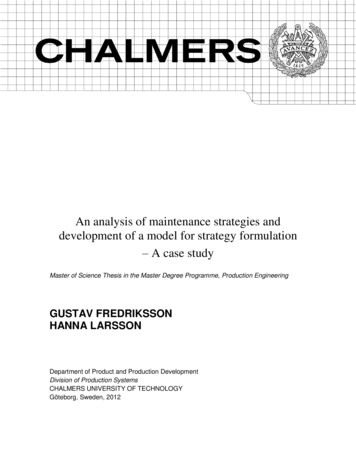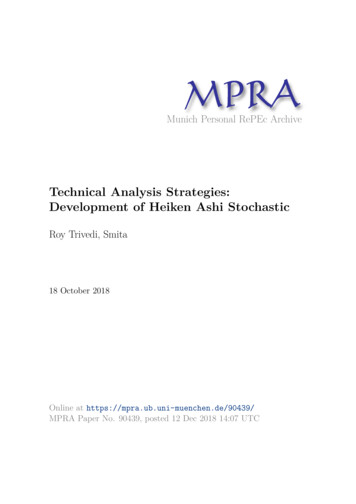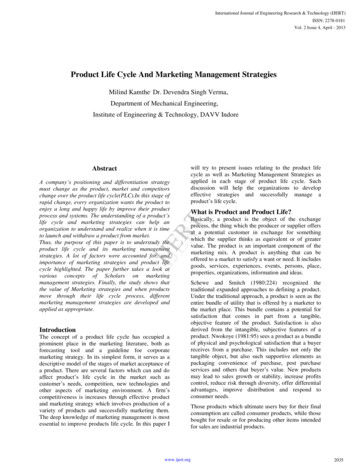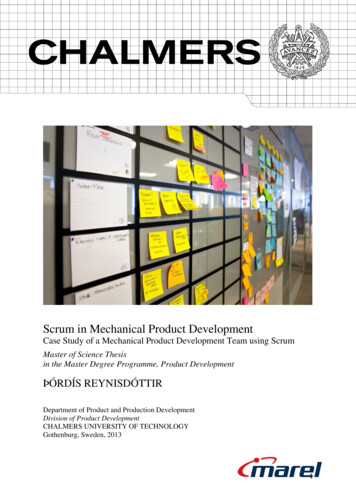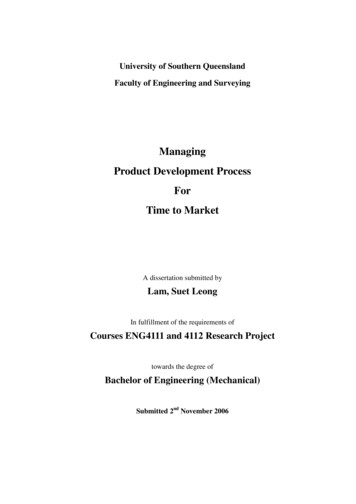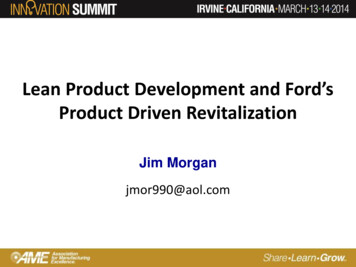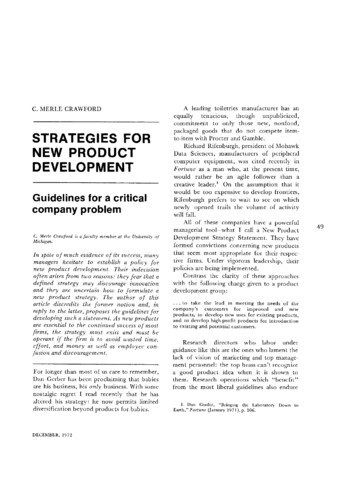
Transcription
C. M E R L E C R A W F O R DSTRATEGIES FORNEW PRODUCTDEVELOPMENTGuidelines for a criticalcompany problemC. Merle Crawford is a faculty m e m b e r at the University o fMichigan.In spite o f much evidence o f its success, manymanagers hesitate to establish a policy fornew product development. Their indecisionoften arises f r o m two reasons: they fear that adefined strategy may discourage innovationand they are uncertain how to formulate anew product strategy. The author o f thisarticle discredits the f o r m e r notion and, inreply to the latter, proposes the guidelines f o rdeveloping such a statement. As new productsare essential to the continued success o f mostfirms, the strategy must exist and must beoperant i f the firm is to avoid wasted time,effort, and money as well as employee confusion and discouragement.For longer than most of us care to remember,Dan Gerber has been proclaiming that babiesare his business, his only business. With somenostalgic regret I read recently that he hasaltered his strategy: he now permits limiteddiversification b e y o n d products for babies.DECEMBER, 1972A leading toiletries manufacturer has anequally tenacious,thoughunpublicized,commitment to only those new, nonfood,packaged goods that do not compete itemto-item with Procter and Gamble.Richard Rifenburgh, president of MohawkData Sciences, manufacturers of peripheralcomputer equipment, was cited recently inFortune as a man who, at the present time,would rather be an agile follower than acreative leader. 1 On the assumption that itwould be too expensive to develop frontiers,Rifenburgh prefers to wait to see on whichnewly opened trails the volume of activitywill fall.All of these companies have a powerfulmanagerial t o o l - w h a t I call a New ProductDevelopment Strategy Statement. They haveformed convictions concerning new productsthat seem most appropriate for their respective firms. Under vigorous leadership, theirpolicies are being implemented.Contrast the clarity of these approacheswith the following charge given to a productdevelopment group :. . . to take t h e lead in m e e t i n g the needs o f thecompany'scustomersfor i m p r o v e dand n e wp r o d u c t s , to develop new uses for existing p r o d u c t s ,a n d to develop h i g h - p r o f i t p r o d u c t s for i n t r o d u c t i o nto existing a n d p o t e n t i a l c u s t o m e r s .Research directors who labor underguidance like this are the ones who lament thelack of vision of marketing and top management personnel: the top brass can't recognizea good product idea when it is shown tothem. Research operations which " b e n e f i t "from the most liberal guidelines also endure1. Dan Cordtz, "Bringing the Laboratory Down toEarth," Fortune (January 1971 ), p. 106.49
C. MERLE CRAWFORD50the most idea rejection, development difficulties, and product failure.Specifically, does the statement of thatcompany limit the search to improving orextending the present product line? Whatdegree of relationship to the present scope ofactivity is necessary for the idea to beacceptable? May the search proceed intounrelated areas? Is search limited to the firm'spresent technological capabilities, distributionsystem, raw materials, and plant and humanresources? Is the door to acquisition open ordosed? Will functional capability be added tomatch each new idea, or should the ideasmatch present functional capabilities?The idea of putting definitive restrictionson the new product activity is not novel, butuse of it, especially sophisticated use, is stillnot widespread. Most large firms have something they call new product strategy but it ismore for directors and stockholders than forserious internal direction; other firms havesketches of such strategy but they are rarelyavailable for personnel down the line from thepresident's office. As the president of amedium-sized firm recently said to me, notentirely in jest: "Sure, we have a new productstrategy; just ask m e ! "Early in this century General Motorscommitted itself to a full line of automobiles,a strategy that proved superior to Ford's.Only recently did Coca-Cola abandon itsstrategy of no line additions. GeneralElectric's approach, a broad attack uponmarkets susceptible to electrical technology,is decades old.Indeed, new product strategies are so old,and in so m a n y cases credited with suchsuccessful outcomes, that one is prompted toask w h y all firms don't have them. There areessentially two reasons:WHATSHOULDINCLUDE?THESTATEMENTThe basic purpose of new product strategy isto provide unifying direction. It specificallynotes any tempting development areas thatare off limits; it clearly specifies those areaswhere effort is to proceed; and it adds anyother direction appropriate and relevant tothe firm, as in the Mohawk strategy. A review of representative strategy statements reveals how the following dimensionsare in actual use.Technology/Market MixAs long ago as 1957, the Harvard BusinessReview ran an article b y Samuel C. J o h n s o nof S. C. J o h n s o n & Son, Inc. and ConradJones of Booz, Allen & Hamilton whichbecame a classic because it spelled out whatwas rapidly gaining fame as the BA/H m e t h o dof organizing the new product function. 2 Thearticle contained a table which should be onpage one of every firm's planning document.It diagramed the alternatives available for newproduct activity as a 3x3 matrix (seeaccompanying table).This table structurally depicts the possiblenine combinations of market and technology.Some, all, or none of these m a y be encouraged, as the applicability of each of theoptions will vary from firm to firm. Unless itvalues new and improved products for theirown sake, any management will want to studythoroughly the various cost/return relationships and stipulate those which it wants tostress and those it wishes to avoid.Market Width1. M a n a g e m e n t is n o t c e r t a i n w h a t such statem e n t s s h o u l d cover.2. M a n a g e m e n t fears t h a t l i m i t a t i o n s m a ydiscourage s o m e useful or s u c c e s s f u l i n n o vation.These are the points to which we will nowturn our attention.The b o t t o m row of the matrix, New Market,provides the third dimension into the consid2. Samuel (2. Johnson, "How to Organize for N e wProducts," Harvard Business Review (May-June 1957), pp.49-62.BUSINESS HORIZONS
Strategies for New Product DevelopmentOptions in the Market-Technology MixNo No onSOURCE: Samuel C. Johnson and Conrad Jones, "How to Organize for NewProducts," Harvard Business Review (May-June, 1957), p. 52.erations the table does not include. There arethe categories of industrial, institutional, andconsumer, of domestic and foreign, and ofspecific product use categories, such as detergents, shoes, boats.If a c o m p a n y has any new productstrategy, it usually covers this dimensionfairly well. Most industrial firms feel at homein institutional markets b u t avoid consumerproducts (if not at first, then several expensive exercises later). Involvement in foreignmarkets is usually deliberate and, in mostsituations, so is choosing broad productcategories. When the United Shoe MachineryCorporation decided to move into other lines,all concerned personnel knew it.But this shouldn't imply for a second thatstrate es score well on this dimension. Infact, y o u can usually start an argument b yasking two executives of the same firm if theirfirm is attempting to move into closely alliedmarkets or product types which it is not nowin. Is the manufacturer of drugs for humanuse willing to enter the veterinary market?Should the soup c o m p a n y market snacks?Two years ago Lyle H. Polsfuss, then vicepresident of marketing for Green GiantCompany, stated that his top management(including the chairman) had delineated thespecific spheres of interest within which newproduct activity would proceed. 3 The fact3. In a speech, as reported(September 1, 1969), p. 51.DECEMBER, 1972in Advertising Age,that a team was developed for each sphereemphasizes the positiveness as well as therestrictiveness of the strategy.Degree of I nnovation/I rnitationThis is the third and last dimension on whichmost managements have made commitments,not because strategic direction is consciouslydesired so much as because innovativeresearch requires different scientific staffs.Thus the product development staff atMohawk Data Sciences is clearly directed totaking someone else's new technology andimproving, or at least individualizing, it insome way. In contrast, the Cabot Corporationis thoroughly committed to innovation andtakes in fifty times as much m o n e y fromlicensing processes as it pays out. 4Examples of both approaches can befound in Theodore Levitt's "InnovativeImitation," an article in which the world'sleading opponent of myopic marketingvigorously pleads for the option of imitation,though it too requires thoughtful development as well as faithful executions, sIf a management wants to assume thehigh-risk/pay-off character of innovative4. Cordtz, "Bringing the Laboratory," p. 108.5. Theodore Levitt, "Innovative Imitation," HarvardBusiness Review (September-October, 1966), pp. 63-70.51
C. MERLE CRAWFORDdevelopment, all persons in positions toinfluence c o m p a n y activities should know it.This applies to imitation as well, or to anyblend of the two.Actually it may be more complicated thana simple innovation/imitation choice. IgorAnsoff and J o h n Steward recently spelled outa four-point scale of orientation:1. First to market., based o n s t r o n g R & D,technical leadership, and risk taking.2. Follow the leader., based on strong development r e s o u r c e s a n d the ability t o a c t quicklyas the market starts its growth phase.3. Applications engineering., based on productmodification to fit the needs of particularc u s t o m e r s i n m a t u r e markets.4. Me-Too. based on superior manufacturingefficiency and cost control. 6Price/Quality Ranges52From this point forward in the considerations, the various dimensions are optional inthe sense that any one firm may or may notfind them desirable. Position on the list(whether here or near the end) carries noimplications.The Campbell Soup Company has anoutstanding reputation, and cares not to loseit. No surprise then that Campbell's productdevelopment people are told: "Prepare andmarket products that represent superiorvalues to consumers and constantly improvethose values. Our products are sound valuesbecause they are made from superior qualityingredients . . . . " Value can come from eitherquality or price b u t Campbell people knowwhich route they are to take. 7In contrast, many firms take the oppositetack. Small appliances purchased in the chaindrugstores, for instance, seem to come frommanufacturers whose position is far to theright on the quality/price spectrum.6. Igor Ansoff and John Steward, "Strategies for aTechnology-Based Business," Harvard Business Review(November-December,1967), pp. 71-83.7. Speech by John W. Dodd, Jr., Sixth Annual NewProducts MarketingConference,Detroit, Mich., March, 1966.The strategy statement of a large pharmaceutical firm contains the expression: "Newproductsmust enhance the company'sstature." It goes on to clarify this b y pointingout, among other things, the need to restrictthe number of products that are modifiedcopies of ones already on the market forwhich low price would be a primary ortempting strategy.Particular Promotional RequirementsThe range of options here is limited only b ythe diversity of marketing tools, b u t it iscustomary for marketing people to orient tothose new products which match currentpromotional strategy or marketing resourcestructure. Just as c o m m o n l y , R & D peopledo n o t - u n l e s s they are told.Several years ago, researchers in WallaceLaboratories were seeking new drug productswhich could be sold b y advertising, since, incontrast to every other firm of significance inthe industry, Wallace had no sales force.Procter & Gamble wants products wherebrand manager skills-advertising, packaging,p r o m o t i o n s - c a n be the deciding factor.Until Metrecal forced a change, MeadJ o h n s o n sought only products which could bep r o m o t e d ethically through the professionalhealth team rather than as proprietaries ontelevision.A certain mini-conglomerate which holdsa major interest in radio stations wants onlythose products which can be effectively advertised on radio. Still other firms want productswhich (1) can be sold through mass merchandisers where the c o m p a n y is strong, (2) can besold b y mail, (3) can be carried b y routesalesmen in small trucks, or (4) need be (orneed not be) sold through state-owned retailoutlets.The list is literally endless, yet within anyone firm the necessary or desirable promotional restrictions are apparent to one whoobserves the marketing operation. One manufacturer of small electrical appliances decidedBUSINESS HORIZONS
Strategies for New Product Developmentto redefine his business as any product withan electric cord at the end of it. But theresulting flow of product ideas and prototypes revealed the folly of not stipulating thepromotional requirements, including tradechannels, that any new electric product wouldhave to meet.Inside vs. Outside FacilitiesPreparing a strategy statement provides theopportunity to decide whether the firm willlimit R & D facilities and personnel. Fewoperating functions are better than research increeping expenses. Each new piece of equipment requires operators and materials, andnew operators inevitably require additionalequipment. Active in-house research anddevelopment programs legitimately require allof these things, and it is temptingly easy to bepenny-wise and pound-foolish.Management is obligated to define theextent
The basic purpose of new product strategy is to provide unifying direction. It specifically notes any tempting development areas that are off limits; it clearly specifies those areas where effort is to proceed; and it adds any other direction appropriate and relevant to the firm, as in the Mohawk strategy.



